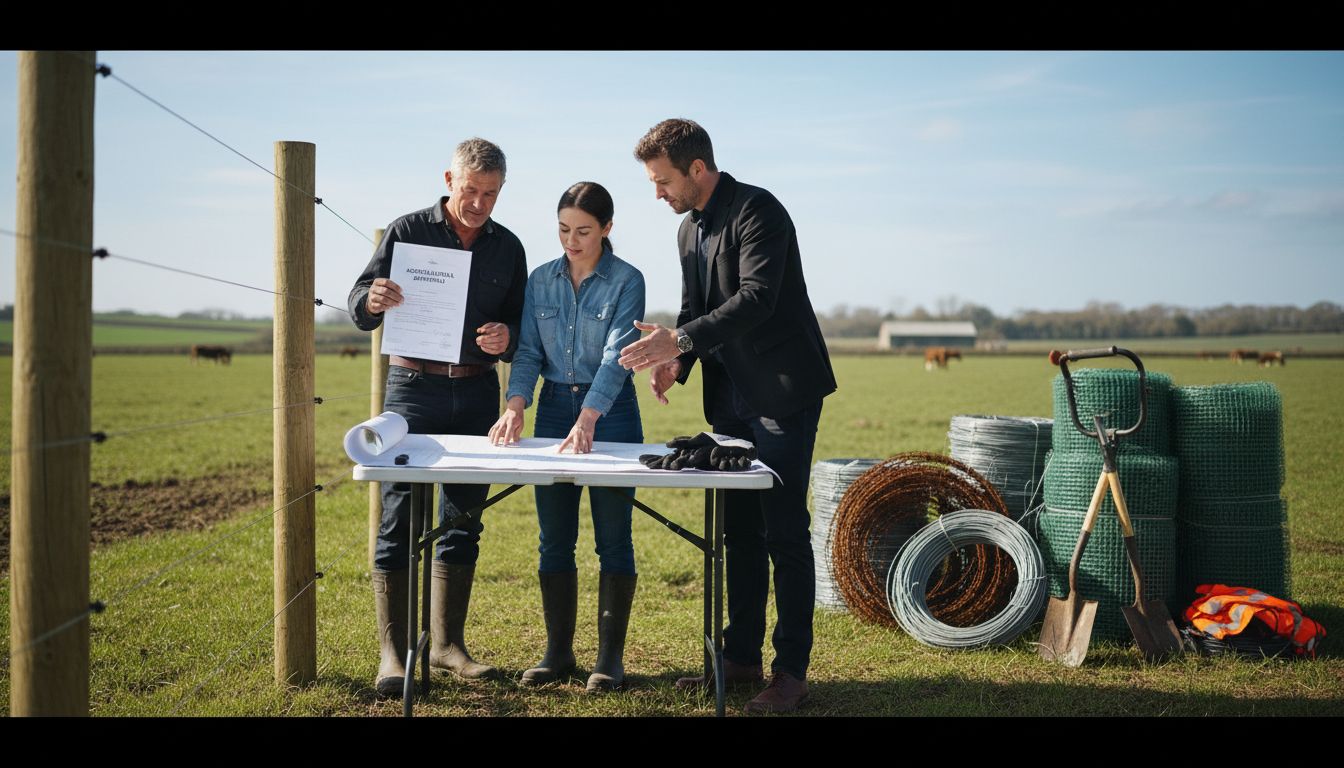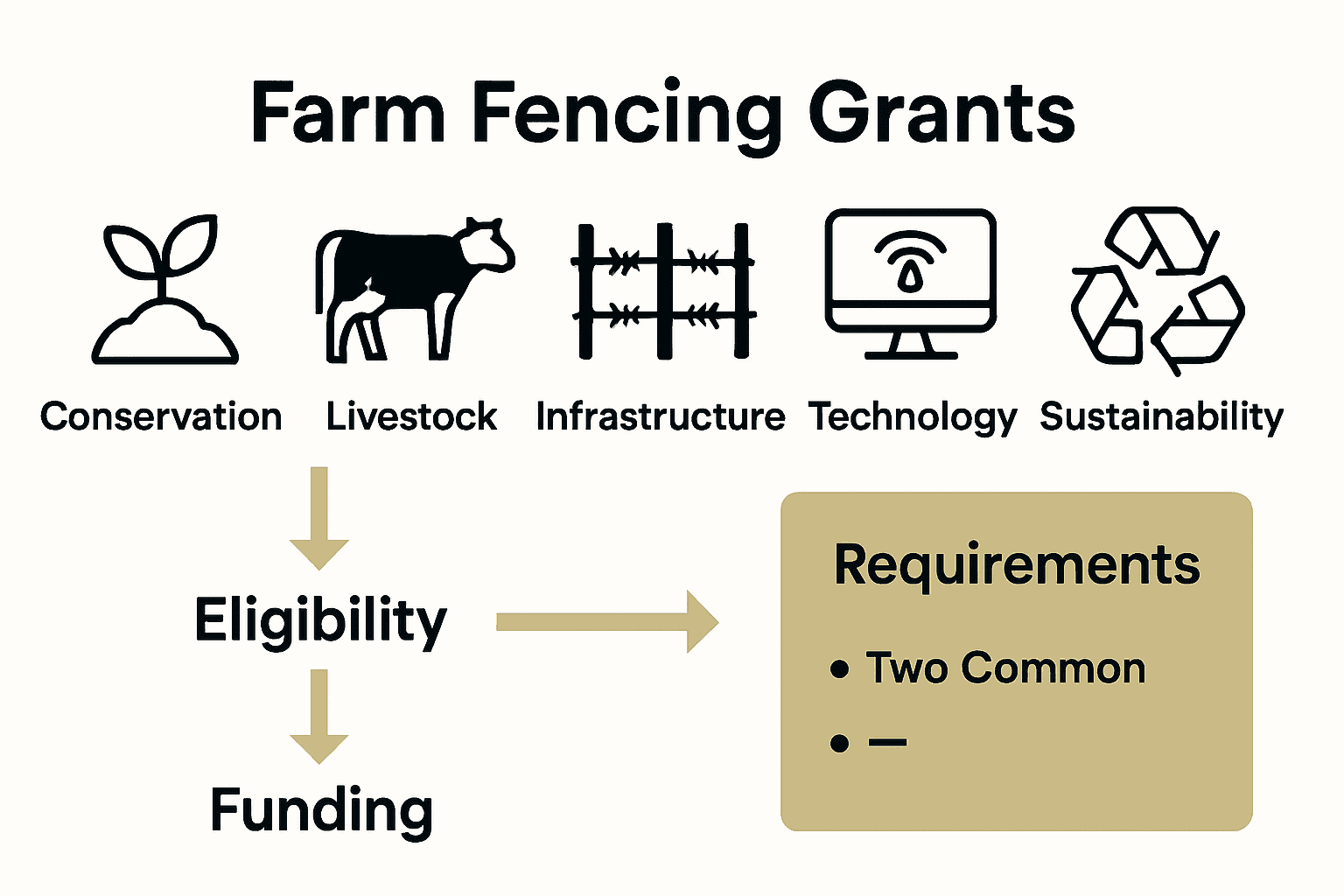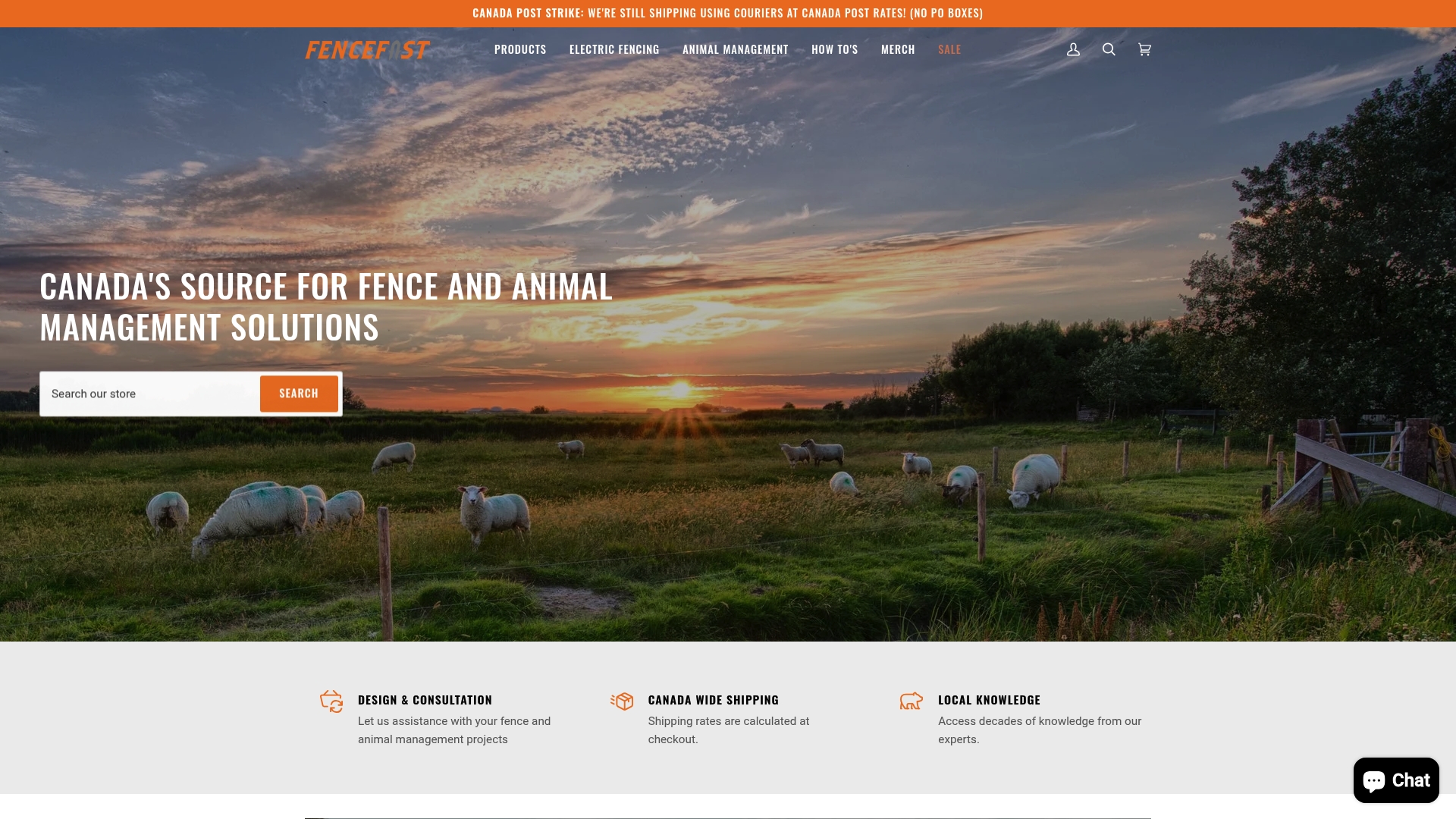Did you know that over $12 billion is distributed annually in agricultural subsidies, much of it supporting vital infrastructure like farm fencing? For farmers, this funding can mean the difference between secure livestock and lost efficiency. Reliable fencing not only protects property but can also improve land management and promote conservation. Understanding how government grants work gives producers a strategic edge in building a stronger, more sustainable farm.
Table of Contents
- Defining Government Grants For Farm Fencing
- Types Of Farm Fencing Grant Programs
- Eligibility Criteria And Documentation Needed
- Application Process And Timelines
- Using Grants: Eligible Costs And Restrictions
- Common Mistakes To Avoid When Applying
Key Takeaways
| Point | Details |
|---|---|
| Diverse Grant Programs | Various types of farm fencing grants exist, focusing on conservation, livestock management, infrastructure, technology, and sustainable agriculture. |
| Eligibility Requirements | Farmers must meet specific criteria such as land ownership verification and project proposals that align with environmental goals. |
| Application Process | A well-prepared application with thorough documentation is essential, with specific timelines and evaluation periods to consider. |
| Common Pitfalls | Avoid frequent mistakes like incomplete documentation and missed deadlines to enhance the success of grant applications. |
Defining Government Grants for Farm Fencing
Government grants for farm fencing represent strategic financial support designed to help agricultural producers enhance their property infrastructure while addressing broader environmental and agricultural sustainability goals. According to Wikipedia, agricultural subsidies are government incentives paid to farmers and agribusinesses to supplement income and manage commodity costs, which can include specific infrastructure improvements like farm fencing.
These grants serve multiple critical purposes beyond simple financial assistance. The Environmental Quality Incentives Program highlights how government support can help farmers implement conservation practices that improve both agricultural productivity and environmental quality. Key objectives of farm fencing grants typically include:
- Supporting rural infrastructure development
- Enhancing livestock management capabilities
- Promoting sustainable agricultural practices
- Protecting agricultural lands and animal resources
- Encouraging responsible land use strategies
Farm fencing grants are not one-size-fits-all financial tools. They vary based on specific regional needs, agricultural contexts, and conservation goals. Farmers can access these grants through various federal, state, and sometimes local government programs designed to provide targeted financial support for infrastructure improvements. 7 Essential Types of Livestock Fencing can offer additional insights into the types of fencing projects that might qualify for such grant opportunities.
Successful grant applications typically require farmers to demonstrate how their proposed fencing project aligns with broader agricultural, environmental, or land management objectives. This means presenting a comprehensive plan that shows not just the immediate benefits to the farm, but the potential wider impact on sustainable agricultural practices and ecosystem management.
Types of Farm Fencing Grant Programs
Farm fencing grant programs represent diverse financial support mechanisms designed to help agricultural producers improve their infrastructure and land management strategies. Government support initiatives offer targeted funding for specific fencing technologies and conservation-focused projects, addressing multiple agricultural needs.
The primary types of farm fencing grant programs typically include:
Here’s a comparison of the primary types of farm fencing grant programs:
| Grant Type | Main Focus | Typical Requirements | Common Funding Uses |
|---|---|---|---|
| Conservation-Oriented | Environmental protection | Sensitive area designation | Wildlife fencing Riparian buffers |
| Livestock Management | Animal containment | Minimum livestock numbers | Permanent fences Gates |
| Infrastructure Development | Property boundaries | Ownership verification | Perimeter fencing Land division |
| Technological Innovation | Advanced fencing solutions | Innovation demonstration | Virtual fencing Smart monitoring |
| Sustainable Agriculture | Ecological balance | Compliance with sustainability | Rotational grazing Eco-friendly materials |
- Conservation-Oriented Grants: Supporting projects that protect environmentally sensitive areas
- Livestock Management Grants: Funding infrastructure improvements for animal containment and pasture management
- Infrastructure Development Grants: Supporting rural property boundary and land division fencing
- Technological Innovation Grants: Providing resources for advanced fencing solutions like virtual fencing technologies
- Sustainable Agriculture Grants: Encouraging land use practices that promote ecological balance
Each grant program has unique qualification criteria and specific objectives. Farmers must carefully evaluate their specific project requirements and align their applications with the precise goals of available funding sources. Understanding Temporary Fencing Solutions can provide additional context for exploring potential grant opportunities related to different fencing approaches.
Successful applicants typically demonstrate clear environmental benefits, agricultural improvements, or technological innovations that extend beyond immediate farm infrastructure needs.
 The most competitive grant proposals showcase how proposed fencing projects contribute to broader agricultural sustainability, land conservation, and ecosystem management goals.
The most competitive grant proposals showcase how proposed fencing projects contribute to broader agricultural sustainability, land conservation, and ecosystem management goals.

Eligibility Criteria and Documentation Needed
Government farm fencing grants have specific eligibility requirements that farmers must carefully navigate to secure funding. UK Government guidelines illustrate how these programs typically require applicants to be farmers, foresters, or land managers with specific land ownership or management credentials.
The core eligibility criteria generally encompass several key components:
- Land Ownership Verification
- Minimum Land Area Requirements
- Agricultural Business Registration
- Compliance with Environmental Regulations
- Detailed Project Proposal
Documentation is crucial in the grant application process. Understanding the Cost of Fencing Per Acre can help farmers prepare comprehensive financial documentation. Applicants must typically submit:
- Proof of land ownership or management rights
- Detailed farm property maps
- Comprehensive project plans
- Itemized fencing project budget
- Environmental impact assessment
- Business registration documents
Additionally, Teagasc highlights that specific programs may have unique requirements, such as maintaining a minimum land area or having a specific number of livestock. Some grants require applicants to demonstrate how their proposed fencing project will improve agricultural productivity, environmental conservation, or land management practices.
Application Process and Timelines
Navigating the farm fencing grant application process requires careful planning and attention to detail. UK Government guidelines emphasize that applicants must submit their proposals during specific application windows, with processing times varying significantly depending on the program and funding source.
The typical farm fencing grant application process involves several critical stages:
- Initial Research: Identify suitable grant programs
- Preliminary Assessment: Evaluate project eligibility
- Document Preparation: Compile required documentation
- Application Submission: Complete and file grant request
- Review Period: Wait for official assessment
- Potential Follow-up: Respond to additional information requests
Timeline considerations are crucial for successful applications. 7 Practical Temporary Fencing Ideas for Rural Properties can provide context for planning your project within potential grant cycles. Teagasc highlights that many agricultural grant programs operate in tranches, meaning applications are accepted during specific periods with distinct deadlines.
Successful applicants understand that flexibility and thorough preparation are key.
Grant timelines can range from a few weeks to several months, depending on the complexity of the project and the specific funding program. Farmers should build buffer time into their project planning, anticipate potential delays, and maintain open communication with grant administrators throughout the application process.
Using Grants: Eligible Costs and Restrictions
Farm fencing grants provide financial support with specific parameters that farmers must carefully understand. UK Government guidelines highlight that these programs typically cover materials and installation costs while imposing strict standards on eligible expenses.
Eligible costs for farm fencing grants generally include:
- Fencing Materials: Wire, posts, gates, and connectors
- Installation Expenses: Labor costs for professional installation
- Site Preparation: Groundwork directly related to fencing project
- Safety Equipment: Specialized safety components for livestock management
- Environmental Mitigation: Costs associated with ecological protection measures
Restrictive conditions are critical to understanding grant utilization. Understanding Temporary Fencing Solutions can help farmers navigate complex funding requirements. Teagasc notes that grant programs often provide funding at specific percentage rates, typically around 60% of total project costs, with maximum investment caps.
Grant recipients must maintain meticulous financial documentation and adhere to program-specific guidelines. Expenses that typically fall outside grant coverage include equipment replacement, routine maintenance, and projects not directly aligned with the program’s environmental or agricultural productivity objectives. Successful applicants understand that comprehensive planning and strict compliance are essential to maximizing grant benefits and avoiding potential financial penalties.
Common Mistakes to Avoid When Applying
UK Government guidelines reveal that many farm fencing grant applications fail due to preventable errors that can be easily addressed with careful preparation and attention to detail. Understanding these common pitfalls is crucial for farmers seeking financial support for their agricultural infrastructure projects.
The most frequent mistakes in farm fencing grant applications include:
- Incomplete Documentation: Failing to provide comprehensive project details
- Missed Deadlines: Submitting applications outside specified timeframes
- Insufficient Project Planning: Lacking a clear, detailed implementation strategy
- Inadequate Cost Projections: Underestimating or overestimating project expenses
- Non-Compliance with Specific Requirements: Overlooking program-specific guidelines
Understanding Temporary Fencing Solutions can help farmers develop more robust application strategies. Teagasc emphasizes that many applicants struggle with the nuanced requirements of agricultural grant programs, often resulting in automatic disqualification.
Successful grant applicants approach the process with meticulous preparation. This means developing a comprehensive project plan, maintaining precise financial documentation, and thoroughly understanding each program’s unique eligibility criteria. Farmers should consider seeking professional guidance, conducting multiple document reviews, and allowing ample time for application preparation to minimize the risk of critical errors that could compromise their funding opportunities.
Secure Your Farm’s Future with Expert Fencing Solutions and Grant Support
Understanding government grants for farm fencing can unlock essential funding for improving your agricultural infrastructure and protecting your livestock. Whether you aim to advance livestock management, enhance environmental sustainability, or install innovative fencing technologies, navigating the complex application process requires reliable equipment and expert guidance.

At FenceFast.ca, we specialize in providing high-quality fencing supplies tailored to the needs of Canadian farmers and ranchers. From durable staples, wires, and connectors to complete electric fencing systems and livestock management tools, our products empower you to complete your grant-funded projects with confidence. Don’t let paperwork and planning challenges hold you back. Visit FenceFast.ca now to explore our full range of solutions and access expert advice that helps you maximize your government grant opportunities. Act today to build stronger, safer, and more efficient farm fencing that supports your long-term agricultural success.
Frequently Asked Questions
What are government grants for farm fencing used for?
Government grants for farm fencing are primarily used to support agricultural producers in improving their property infrastructure, enhancing livestock management, promoting sustainable agricultural practices, and protecting agricultural lands and animal resources.
How do I apply for a farm fencing grant?
To apply for a farm fencing grant, you must identify suitable programs, evaluate project eligibility, compile the required documentation, complete and submit your application during designated windows, and wait for the review period for assessment.
What costs are typically covered by farm fencing grants?
Farm fencing grants typically cover costs related to fencing materials (like wire and posts), installation expenses, site preparation, safety equipment, and environmental mitigation associated with fencing projects.
What common mistakes should I avoid when applying for a farm fencing grant?
Common mistakes to avoid when applying for a farm fencing grant include incomplete documentation, missed deadlines, inadequate project planning, insufficient cost projections, and non-compliance with program-specific requirements.
